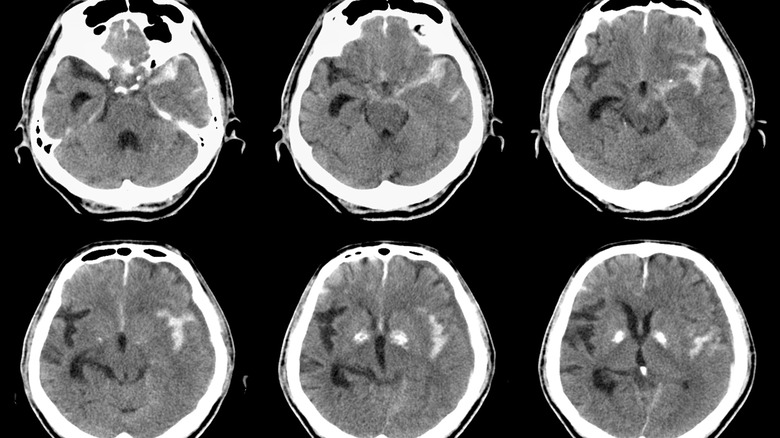The Health Scare You Didn't Know Emilia Clarke Had
In 2011, very soon after she had finished filming the first season of "Game of Thrones," actress Emilia Clarke suffered from a near-death experience. "Just when all my childhood dreams seemed to have come true," she told The New Yorker in 2019, "I nearly lost my mind and then my life."
In the midst of a training session at her North London gym, Clarke began to develop an intense headache. Before long, she "felt as though an elastic band were squeezing [her] brain." She barely made it to the locker room before she was violently ill and in debilitating pain. She was quickly taken to a nearby hospital where a brain scan revealed she had a subarachnoid hemorrhage, which is bleeding around the brain caused by a ruptured blood vessel, or aneurysm (via John Hopkins Medicine). "For the next three hours, surgeons went about repairing my brain. This would not be my last surgery, and it would not be the worst. I was twenty-four years old."
As Clarke recovered from the surgery, she suffered from unbearable pain and a neurological disorder called aphasia, which impaired her ability to talk. "I'd never experienced fear like that — a sense of doom closing in," the actor revealed. "I could see my life ahead, and it wasn't worth living. I am an actor; I need to remember my lines. Now I couldn't recall my name."
A second aneurysm
Before Emilia Clarke finished her month-long stay at the hospital, another smaller aneurysm was discovered. She was able to wait a couple of years before treating it, during which she suffered greatly from fatigue and dizziness. "On the set, I didn't miss a beat, but I struggled. Season 2 would be my worst. I didn't know what Daenerys was doing. If I am truly being honest, every minute of every day I thought I was going to die," she admitted to The New Yorker.
In 2013, a routine brain scan revealed that the second aneurysm had doubled in size, and they needed to operate immediately. "When they woke me, I was screaming in pain," Clarke said. "The procedure had failed. I had a massive bleed and the doctors made it plain that my chances of surviving were precarious if they didn't operate again. This time they needed to access my brain in the old-fashioned way — through my skull." A third operation was performed immediately.
Recovery was especially difficult after this surgery. "I looked as though I had been through a war more gruesome than any that Daenerys experienced," the actor said. After another month in the hospital filled with anxiety and panic attacks, Clarke finally recovered. She went on to help develop a charity called SameYou, which helps people recovering from brain injuries and stroke. And she's not silent about her health scare anymore. "Now, after keeping quiet all these years, I'm telling you the truth in full," she told the publication.
Subarachnoid hemorrhage: Symptoms and outlook
Emilia Clarke's fear and hopelessness about her condition was understandable — one in 10 patients who experience subarachnoid hemorrhage die before reaching the hospital, one in four die within the first 24 hours, and half of patients die in the first six months (via Medscape). So what exactly is it?
An aneurysm happens when a blood vessel on the surface of the brain ruptures (via Johns Hopkins Medicine). The blood leaks into the area between the brain and the skull and increases pressure on the brain, also called a subarachnoid hemorrhage, leading to possible brain cell damage and disabilities. Common symptoms of a subarachnoid hemorrhage include loss of consciousness, nausea or vomiting, trouble speaking, confusion, sensitivity to light, and a severe headache that feels like the worst headache pain you've ever experienced. It's typically diagnosed by an MRI scan or CT scan, although usually it goes undetected until after an aneurysm has already occurred. Immediate treatment, usually surgery, is necessary to stop the bleeding as soon as possible. The biggest risk factor is smoking, diabetes, high cholesterol, and high blood pressure can also contribute. You can also help to reduce your risk by keeping a balanced diet and sustaining a healthy body weight.
While subarachnoid hemorrhage usually occurs in people over 40 years old, Clarke is an example of an exception to this rule. If you experience any of the symptoms above, seek medical treatment immediately.



